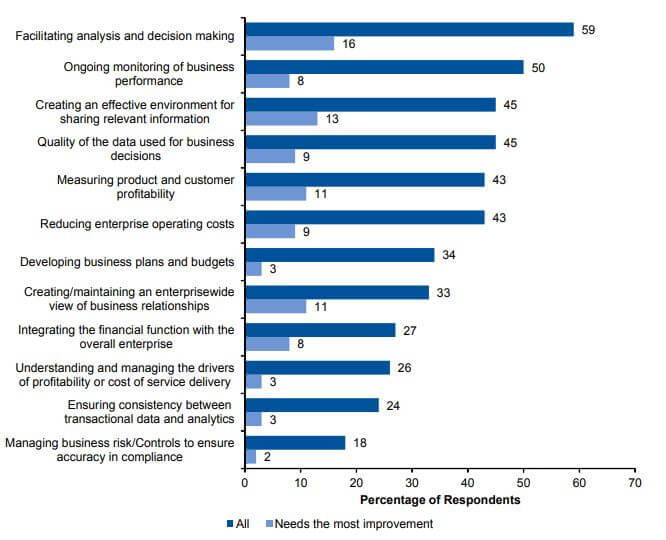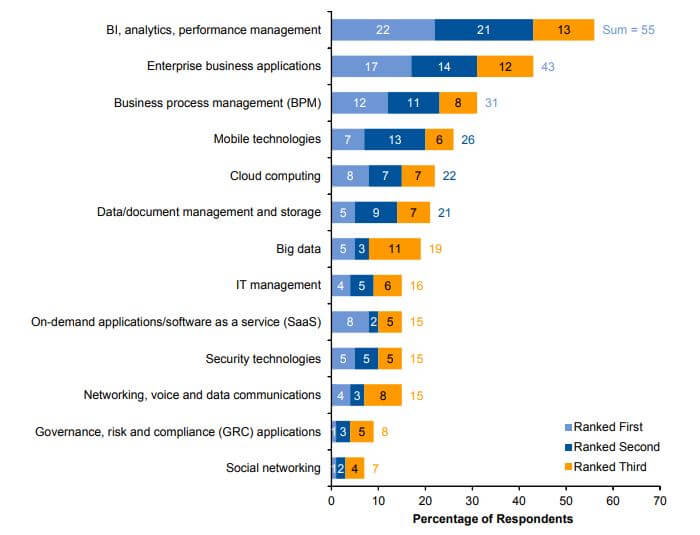By assessing the results from 169 online surveys carried out throughout 2015, Gartner structures the main findings into 8 very interesting points.
The key thing to note is that the finance and information technology departments are becoming more closely aligned. Separate research by CIMA and AICPA shows that 56% of CFOs report that the role of the CFO has increased regarding information technology and data management, which is expected in a digital age. The main points from the Gartner study corroborate the CIMA/AICPA research, but also includes some additional findings which are useful in gaining an understanding of the CFO’s ever-expanding role in companies today.
1. Organizations are still struggling with analytics
The list of areas in Fig.1 shows that analysis and decision making (60%) is the top area needing improvement. More than half of the CFOs also mentioned the need to improve the quality of data for decision making, and the need for ongoing monitoring of business performance. It’s not a shock, then, that the next finding shows that analytics increasingly features as an area of investment.

2. CFOs are taking advantage of digital business
The report showed that 81% of organizations use at least one of the nexus capabilities which includes social, mobile, cloud, and information, just 12% don’t use any of them, and 18% use all four. The use of the following areas by CFOs are on the rise since the last survey in 2014; analytics (44% to 58% – consistent with the observation above of analytics as a top area for investment), cloud (46% to 57%), and mobile (44% to 47%).
3. Cloud usage is increasing for finance-focused applications
As we see the trend of businesses taking advantage of digital capabilities, the use of the cloud has doubled since 2014 for business analytics, integrated financial management applications and corporate performance management (CPM) areas. Gartner suggests the reason for this is that finance departments are becoming more comfortable with the idea of using the cloud, and many are considering cloud-based alternatives for their on-premise systems. Interestingly, 81% of organizations forecast a move to the cloud for more than 50% of their future transactions, which will drive even more IT decisions.
4. Business analytics investments are becoming more popular, but security is still a major concern
As cloud adoption increases, investing in business applications is forcing the move to the so-called ‘postmodern ERP’ (a hybrid of on-premises, private, and public cloud deployments), while there is increasing demand for mobile and analytics capabilities. The top 3 most important technology-related investment areas are business analytics, IT security, and enterprise business applications. For larger companies (more than $1 billion in revenue per year) was the area of top investment and business applications was the top investment for smaller companies (less than $50 million in revenue per year).

5. CPM are leading BI and analytics investments
CFOs were asked which of the technologies are currently being upgraded or enhanced and CPM areas accounted for the majority of business intelligence/analytics-related investments. Performance measurement/scorecards is still the biggest focus but it slips slightly from 52% in 2014 to 49%. Financial reporting and consolidation is up from 50% to 43%, and customer and product profitability is also rising, Gartner suggests mostly due to the availability of corporate planning and modeling solutions that make this approach easier.
6. CFOs have a major influence on technology as many IT decisions are shifting to business areas
The CFO’s influence over IT is consistent and, in many organizations, growing. In larger organizations, the influence is significantly less as CIOs are less likely to report to the CFO. The midsize group (revenue between $50 million and $1 billion) had the highest occurrence (58%) in the study. Gartner does acknowledge, however, that this result may be biased by the fact that technology-minded CFOs are more likely to complete the survey.
7. Most CFOs think IT is not transformational
Just 3% of those surveyed think that IT is transformational. It leads to us questioning what exactly they think of IT. The report shows that most think of IT as a way of improving efficiency (41%), enabling business operations (20%) and enhancing them (24%). Only 11% believe that IT is a primary source of competitive advantage.
8. Postmodern ERP approaches to business applications are firmly established
According to Gartner “many ERP systems and legacy business applications have lost business relevance and agility” and this is why the majority of organizations have already moved away from a monolithic ERP approach into the Gartner-coined ‘postmodern ERP’ approach. 37% of respondents use a hybrid approach with on-premise (from ERP vendors) and cloud applications, and only 28% said that they buy all products and extensions from ERP providers. Gartner recommends defining the ERP skills gap in your organization, focusing on areas like integration technologies, cloud technologies, and automation.



